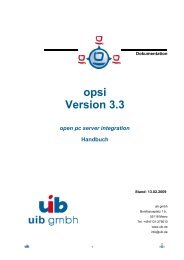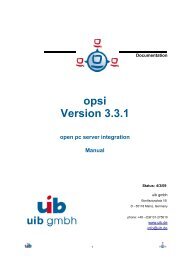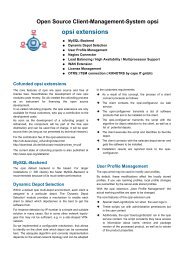opsi manual opsi version 4.0.2 - opsi Download - uib
opsi manual opsi version 4.0.2 - opsi Download - uib
opsi manual opsi version 4.0.2 - opsi Download - uib
Create successful ePaper yourself
Turn your PDF publications into a flip-book with our unique Google optimized e-Paper software.
<strong>opsi</strong> <strong>manual</strong> <strong>opsi</strong> <strong>version</strong> <strong>4.0.2</strong><br />
91 / 193<br />
/etc/<strong>opsi</strong>/hwaudit/locales/de_DE, one would see that the attribute of "COMPUTER_SYSTEM.systemType" will<br />
be translated into "Typ" for German. Finally another suggestion: When a new field is created, it should be placed in<br />
these files, even if one does not translate the term explicitly. This avoids any "Warning" messages.<br />
10.2 Software Inventory<br />
The software inventory is done with the Localboot product swaudit. In this case, information will be inherited from<br />
the uninstall of the Registry, and additional information will be obtained from the Hotfixes and License keys.<br />
The source code for these packets can be found here:<br />
https://svn.<strong>opsi</strong>.org/listing.php?repname=swaudit<br />
11 <strong>opsi</strong>-server<br />
11.1 Overview<br />
The functionality of a <strong>opsi</strong>-server may be installed on many different kind of linux distributions.<br />
There are two different roles which a <strong>opsi</strong>-server can play:<br />
• <strong>opsi</strong>-config-server<br />
The <strong>opsi</strong>-config-server has the central data storage and provides the access to this data via the <strong>opsi</strong> web service.<br />
A <strong>opsi</strong>-config-server normally has additiona the role <strong>opsi</strong>-depot-server.<br />
• <strong>opsi</strong>-depot-server<br />
The <strong>opsi</strong>-depot-server has no configuration data storage. The <strong>opsi</strong>-depot-server hold the installation files at a share<br />
and provides the PXE/tftpboot services for the netboot products.<br />
The hardware requirements are low. The <strong>opsi</strong>-server can also run as a virtual instance, e.g. vmware®<br />
(www.vmware.com).<br />
11.2 Installation and initial operation<br />
Installation and start-up of the <strong>opsi</strong>-server is described in the <strong>opsi</strong> getting started <strong>manual</strong>.<br />
11.3 Samba Configuration<br />
The <strong>opsi</strong> depot server provides network shares holding the configuration information and the software packets. These<br />
shares can be mounted by the clients. For Windows Clients the shares are provided by SAMBA (<strong>version</strong> 3.x).<br />
To configure your samba according to the needs of <strong>opsi</strong> (or to repair) call:<br />
<strong>opsi</strong>-setup --auto-configure-samba<br />
After every change of the samba configuration, you have to reload your samba (/etc/init.d/samba reload).<br />
11.4 The daemon <strong>opsi</strong>confd<br />
The <strong>opsi</strong>confd is the central <strong>opsi</strong> daemon (service). The <strong>opsi</strong>confd provides the <strong>opsi</strong> web service and does a lot things<br />
more. The <strong>opsi</strong>confd is configured by /etc/<strong>opsi</strong>/<strong>opsi</strong>confd.conf.








